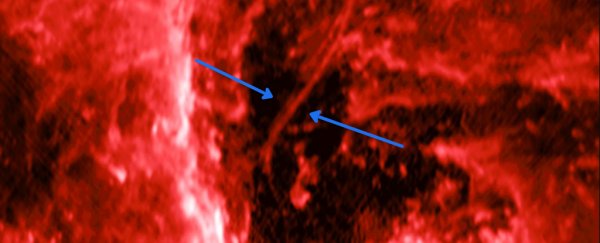Astronomers have produced a clear snapshot of a 2.3 light-year long 'thread' snaking around the supermassive black hole at the centre of the Milky Way.
The structure itself was discovered back in 2012, but the new image reveals the long line seems to be fairly intimate with the dark heart of our galaxy. While a closer look helps narrow down possibilities on what it might be, astronomers are still far from a solid answer.
A small team of researchers produced the image using data from the National Radio Astronomy Observatory's (NRAO) Karl G. Jansky Very Large Array, and applied a novel imaging technique to help clean up the detail.
Take a look at it below in all its glory.
 (NSF/VLA/UCLA/M. Morris et al.)
(NSF/VLA/UCLA/M. Morris et al.)
To most of us, the result looks like a terrifying glimpse into the mouth of Hell only to see dental floss stuck to one of its teeth. To astronomers, it's an exciting question begging for an answer.
"Part of the thrill of science is stumbling across a mystery that is not easy to solve," says astronomer Jun-Hui Zhao from the Harvard-Smithsonian Centre for Astrophysics in Cambridge.
"While we don't have the answer yet, the path to finding it is fascinating. This result is motivating astronomers to build next generation radio telescopes with cutting edge technology."
Finding long streams of gas or lines of glowing particles extending through regions of space isn't unusual.
Structures such as this one – also referred to as a nonthermal radio filament (NRF) – have been observed floating around the middle of our galaxy previously. Most are a lot longer, but their origins are still a mystery.
Originally it was suspected they had something to do with the Milky Way's magnetic fields, but as more filaments were discovered flowing in odd directions, that idea was soon thrown in the bin.
What makes this one particularly unusual is that it seems to be tickling the event horizon of Sagittarius A* (Sgr A*), the gargantuan black hole 4 million times heavier than our Sun occupying the middle of our galaxy.
That opens some intriguing possible explanations for why long queues of particles excitedly beam light in the radio wave part of the electromagnetic spectrum.
First, let's get the least exciting option out of the way – this mightn't be anything exciting. Just a run of the mill NRF that simply looks like it's connected to a black hole.
In other words, it might be the astronomical equivalent of a galactic hair in front of the lens. But according to the astronomers, that's extremely unlikely - even if we can't dismiss it outright.
The odds-on favourite hypothesis suggests the thread is made of particles being jettisoned away from Sgr A*.
Rushing swirls of particles being pulled into a black hole can create a strong magnetic field, which in turn acts like a particle accelerator. Charged particles channelled at ridiculous speed could explain a thin, glowing stream.
The other, less likely (but more exciting) possibility is that it's actually a hypothetical object known as a cosmic string.
Cosmic strings are thought to be immensely massive one-dimensional 'topological' defects that form between different parts of a vacuum as space expands. In other words, they're like cracks in space that formed when our infant Universe was stretching itself apart.
Given that these things should be absolutely massive, if cosmic strings exist, the middle of a galaxy would be a good place to look for some.
So far we just don't know for sure, so astronomers are still gathering more evidence to rule out either of the hypotheses.
But whatever it is, pinning down the nature of the strange filament will be a boon for astronomy. If it's particles being shot out of Sgr A*, that would teach us more about magnetic fields in this highly chaotic zone.
Meanwhile, spotting a cosmic string in the wild would be a profound discovery in its own right, one that tells us a lot about the very nature of the Universe and its origins.
"We will keep hunting until we have a solid explanation for this object," says Miller Goss from the NRAO. "And we are aiming to next produce even better, more revealing images."
We can't wait.
This research was published in The Astrophysical Journal Letters.
